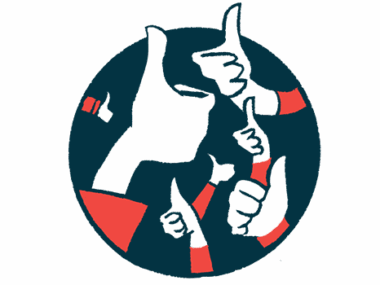Pivotal DREAMM-2 Trial Supports Belantamab Mafodotin’s Use for Heavily-treated Multiple Myeloma
Written by |

Treatment with belantamab mafodotin, GlaxoSmithKline’s investigational antibody-drug conjugate, resulted in clinically meaningful responses in about one-third of hard-to-treat multiple myeloma patients included in the DREAMM-2 trial, the company announced.
Findings from the open-label DREAMM-2 study (NCT03525678) — which is assessing two different doses of belantamab mafodotin as a fourth-line or later therapy — also demonstrated that the treatment has a manageable safety profile and induces long-lasting responses, with most patients in each dose still responding after about six months of follow-up.
Results were published in The Lancet Oncology, in an article, titled “Belantamab mafodotin for relapsed or refractory multiple myeloma (DREAMM-2): a two-arm, randomised, open-label, phase 2 study.”
Despite many therapeutic advances for multiple myeloma in recent years, treatment for patients who fail to respond (refractory) or progress after first responding (relapsed) to current approaches is still challenging. Thus, effective and safe new therapies are needed for patients who have exhausted all available treatment options.
B-cell maturation antigen (BCMA) is a cell surface receptor present on virtually all multiple myeloma cells, but is absent on normal B-cells, making it an ideal target for therapy.
Belantamab mafodotin — granted breakthrough therapy designation by the U.S. Food and Drug Administration (FDA) in 2017 — is an antibody-drug conjugate that targets BCMA. It is composed of an anti-BCMA monoclonal antibody bound to auristatin F, a molecule that causes cell death. After belantamab mafodotin binds to BCMA, the cancer-killing molecule is released into the cell and kills it.
The first human trial testing belantamab mafodotin, the DREAMM-1 Phase 1 trial (NCT02064387), showed that the treatment was safe and well-tolerated and significantly reduced tumor burden in 60% of relapsed or refractory patients included in the trial, including 15% with complete tumor clearance. These patients lived for a median of 12 months without any signs of disease worsening.
The DREAMM-2 Phase 2 clinical trial (NCT03525678) was designed to test belantamab mafodotin in patients that had more advanced disease and a poorer prognosis.
“Overall, patients in DREAMM-2 had more advanced disease, poorer prognosis and performance status and also had a greater number of prior lines of therapy in comparison with patients in DREAMM-1,” GSK stated in a press release.
These patients had received at least three prior lines of therapy and had failed to respond to an immunomodulatory agent such as Revlimid (lenalidomide), a proteasome inhibitor such as Velcade (bortezomib), and an anti-CD38 antibody such as Darzalex (daratumumab).
The trial enrolled 196 patients, who were randomly assigned to receive one of two belantamab mafodotin doses — 2.5 mg/kg (97 patients) or 3.4 mg/kg (99 patients) — once every three weeks. These patients had received a median of seven prior lines of therapy, with some having been treated up to 21 times.
DREAMM-2’s primary goal was to determine the proportion of patients responding to treatment. Secondary measures included duration of response, time to disease progression or death, overall survival, safety, and a number of laboratory assessments.
After a median follow-up of 6.3 months for the 2.5 mg/kg dose and 6.9 months for the 3.4 mg/kg dose, 31% of patients taking the lower dose and 34% of the higher-dose group had achieved an overall clinical response, including 19% and 20% very good partial responses or better. Three patients in each dose group achieved complete responses.
Patients in the lowest dose group lived without disease progression for a median of 2.9 months, a length of time that rose to 4.9 months among those receiving the highest dose.
Survival data is not mature yet, as more than half of patients in each group were alive at the time of the analysis. “Longer-term follow-up is needed to establish whether these findings will confer an overall survival benefit,” the researchers wrote.
“Each day in my practice, I see patients who would benefit from additional therapeutic options because their disease has advanced and is no longer responding to available treatments,” Sagar Lonial, MD, of the Winship Cancer Institute of Emory University, and principal investigator for DREAMM-2, said in the release.
“The data published today from DREAMM-2 not only reinforce the significance of BCMA as a potentially viable target, but also underscore the potential of belantamab mafodotin, if approved, as a practical treatment option in this patient population,” he added.
The safety and tolerability of belantamab mafodotin was consistent with the DREAMM-1 trial. The most frequent serious side effects included blurred vision, low platelet counts, and anemia. More patients on the highest dose had to reduce their treatment dose during the trial, and more of these patients died due to a serious adverse event (7% versus 3% for the lowest dose). Two deaths were considered potentially related to belantamab.
Based on these results, GlaxoSmithKline is filing an application with the FDA to request that the 2.5 mg/kg dose of belantamab mafodotin be approved for the treatment of hard-to-treat multiple myeloma.
As part of the DREAMM clinical trial program, GSK is conducting additional studies to test the therapy in combination with standard and new treatments in myeloma patients who failed one or two prior lines of therapy.
In the U.S., belantamab mafodotin is available for compassionate use by relapsed or refractory multiple myeloma patients as part of an expanded access program (NCT03763370). For more information on eligibility and access, go here.






